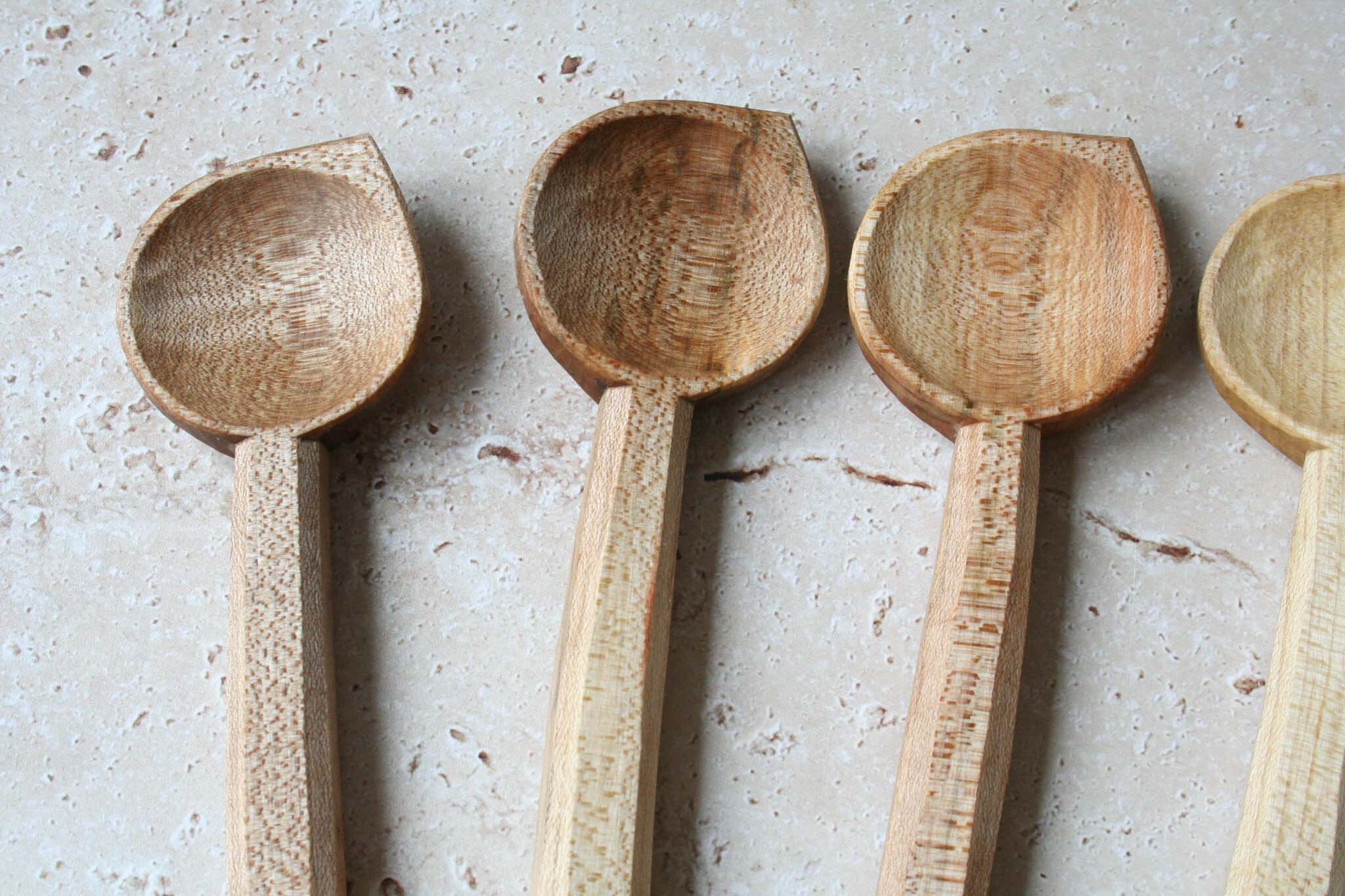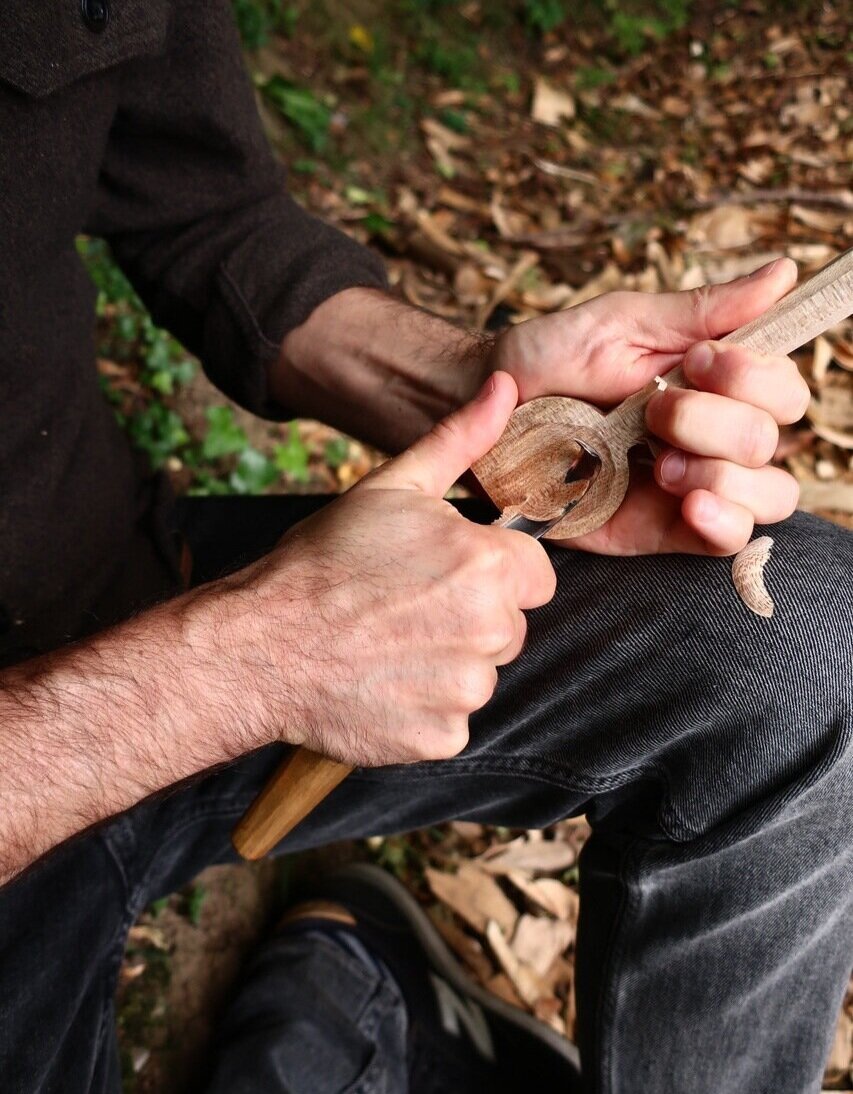Unique hand carved spoons by Will
One of the items I really wanted to add to the Cooking & Carafes Shop was a beautiful cooking spoon. I always use wooden cooking spoons at home, I don’t know why but I prefer using these to other utensils we have. Of course you can easily buy one of these from a homeware store but the spoons in the shop are special, read on to find out what makes each one unique and how they are hand carved.
Who makes the spoons?
Will Priestley hand carves everyone, he carves the spoons down in Glastonbury, Somerset.
Will’s been making spoons for over six years and refers to himself as a ‘green woodworker’ because he works with fresh wood, rather than dried or seasoned. Will says about the process “It’s very much about using the natural properties of the wood (like natural bends, grain structure, flexibility etc.) to dictate the final product. As such, no two end results are exactly the same.” He always uses sustainable wood sourced from local conservation projects and uses a variety of woods.
Will began spoon carving as a hobby encouraged through his work with a conservation charity where he led volunteer groups on practical tasks like coppicing, hedge-laying and scrub clearance.
He explains “Fast forward to today and the hobby has replaced the work! I still get all of my wood from local conservation projects, foraging my own wood and knowing exactly where it came from and the reason the trees were felled is very important to me. I only carve hardwoods that are native to Britain, my favourites being cherry, sycamore, alder and birch but I’ll give anything go, really!
Aside from the chainsaw that felled the tree, there are no power tools in my process. I saw the wood to size by hand, split and rough shape it with an axe and finish with knives. By keeping my tools extremely sharp, I can leave a beautifully smooth finish on the wood. I like to think of the faceted tools marks as a lasting link between the spoon and its maker so, for this reason, I never use sand paper.”
Like myself with pasta making, Will finds his hobby, and now his work extremely therapeutic and sees it as a relaxing and meditative practice. He says “It’s a wonderful way to take your mind off the stresses of every day life, to connect with nature and see a project through every step of the way, from tree to spoon, in a way that most other crafts cannot. In the same way the food tastes better when you have grown the food yourself, eating or cooking with your own handmade spoons makes any meal that bit more enjoyable!”
Will talks through the process and how he carves each spoon
I start by splitting the wood using an axe and a big whacker (technical term).
Still with the axe, I roughly shape the spoon. The closer I can get to the final shape, the less knife work I’ll have to do.
I use a carving knife to refine the shape. It’s very easy to be complacent and cut yourself so by learning safe techniques and making them habit, accidents become very few and far between.
I hollow the bowl of the spoon using a knife with a curved blade
Lastly, is to soften some of the edges with the carving knife. These cuts are important as they make the spoon more comfortable to use and more durable.
Carefully softening the shape with a carving knife
I let the spoon dry for a few days before I paint the handle or leave it au natural. I use milk paint to decorate my work; it’s a mix of milk protein, lime powder and natural pigment that just needs water. Once the paint is dry, I treat the spoon with pure linseed oil. This helps to waterproof the spoon and bring the colour of the wood out really nicely. After a few more days to let the oil dry (sunlight really helps speed this up), the spoon is ready to be sent out in to the world…
And into your kitchen!
Each spoon has a pointed edge so you can get right round the edges of the pan, this makes it great for things like risottos and tomato sauces. It also means spoons can be right or left handed. I use a left handed one. Please make sure you choose the correct one when ordering, if it isn’t available please email kate@cookingandcarafes.co.uk to be added to a pre-order.













